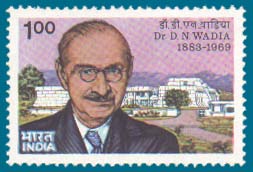
INSTITUTE OF HIMALAYAN GEOLOGY, DEHRA DUN
& DR D.N.WADIA

Professor Darashaw Nosherwan Wadia, a pioneer in Indian Geology, was born on 23rd October 1883 at Surat, in a respectable family of ship-builders for the East India Company. Young Wadia had his early education in Surat and Baroda, and obtained his Bachelors degree in 1905 from Baroda College. Soon after, he took up the challenging task of setting up the Department of Geology at the Prince of Wales College in Jammu and wrote a textbook for Indian students of the Geology of India and Burma, in 1916. This classic book brought him recognition both at home and abroad, and has had a profound influence on generations of students of geology.
In the inspiring surroundings of the Kashmir Himalayas and under the able guidance of C. S. Middlemiss, young Professor Wadia continued his geological pursuits and formed some new ideas regarding the origin and evolution of the Himalayas. He joined the Geological Survey of India in 1921, to further work, on the geological and tectonic mysteries of the North Western Himalayas. His paper on the "Syntaxis of the North Western Himalayas" the acute arcuate knee-bend of the entire Himalayan belt around a pivotal point of Nanga Parbat, brought him national and international fame.
After retirement from the GSI in 1938, Wadia worked for some time with the Government of Ceylon, till 1944, when he was appointed the Geological advisor to the Government of India, to initiate and formulate a mineral policy for the country. He continued to advise the Government on matters related to conservation and utilization of the country's mineral resources, exploration for domestic resources for atomic raw materials and other related fields. The Indian Bureau of Mines, Atomic Minerals Division, National Geo-physical Research Institute, National Institute of Oceanography and the Institute of Himalayan Geology, are some of his creations. The Institute of Himalayan Geology, established in 1968, was renamed as the Wadia Institute of Himalayan Geology in his memory in 1971.
Professor Wadia’s genius and merit found widespread recognition in the World. He was awarded the 'Back Award' of the Royal Geographical Society in 1934, 'Lyell Medal' of the Geological Society of London in 1943, the Honorary Doctorate of the Delhi University in 1947, elected a Fellow of the Royal Society of London in 1957, 'Meghnad Saha Medal' of the Indian National Science Academy, 'P. N. Bose Memorial Medal' of the Asiatic Society and 'Leopold Yon Buch' Award of the German Geological Society.
The Government of India honoured him with the award of Padma Bhusan, and made him a National Professor in Geology in 1963. Besides being the President of the Indian Science Congress, the National lnstitute of Sciences of India and many scientific societies, he was also elected to fill the Presidential Chair of the International Geological Congress in New Delhi, in December 1964. As a true Karma Yogi, he remained active till the end and breathed his last in New Delhi on June 15, 1969 at the age of 86.
The Indian Posts & Telegraphs Department is privileged to issue a commemorative stamp in honour of this pioneer in Indian Geology and development of geo-scientific research in the country.
(Text courtesy: The Wadia Institute of Himalayan Geology, Dehradun).
Description of Design
The 100 p denomination stamp designed by India Security Press, Nasik depicts a portrait of Dr. D. N. Wadia with the building of the Wadia Institute of Himalayan Geology, Dehra Dun in the background. The first day cover shows Dr. Wadia working at a microscope. The cancellation showing the geological hammer used by Dr. Wadia has been designed by Nenu Bagga.
Date of Issue: 23.10.1984